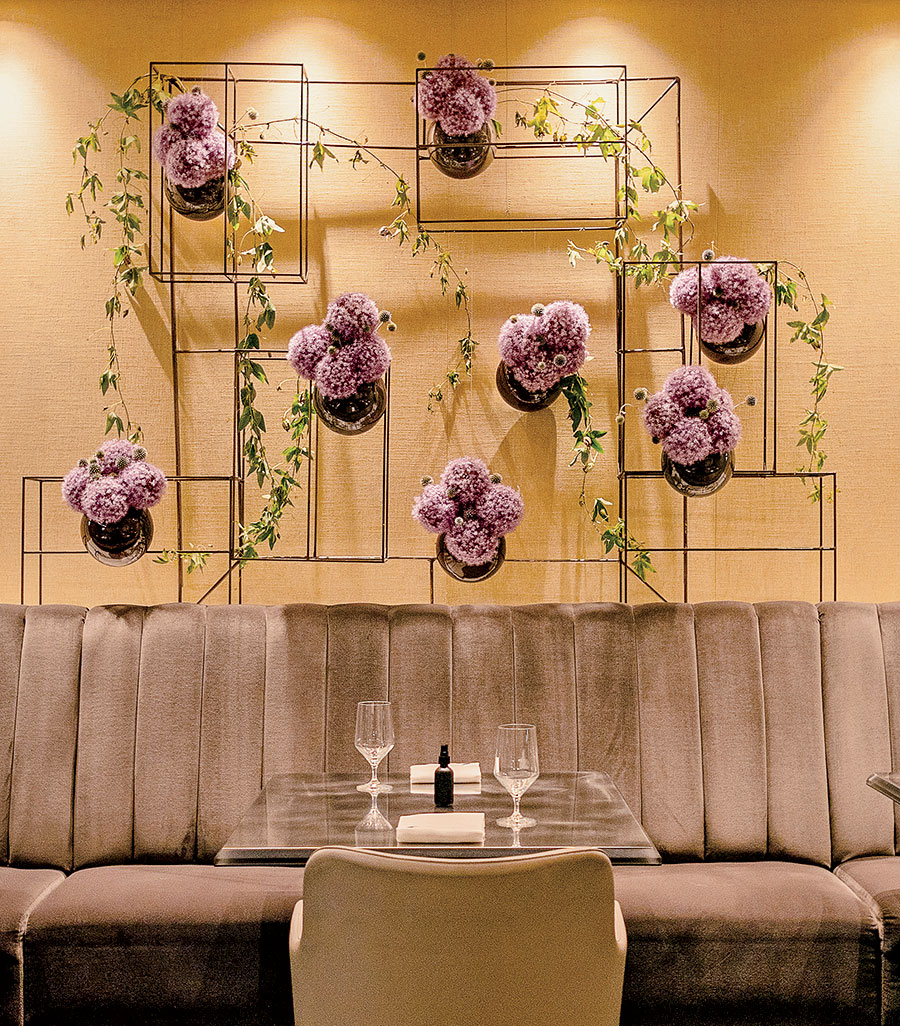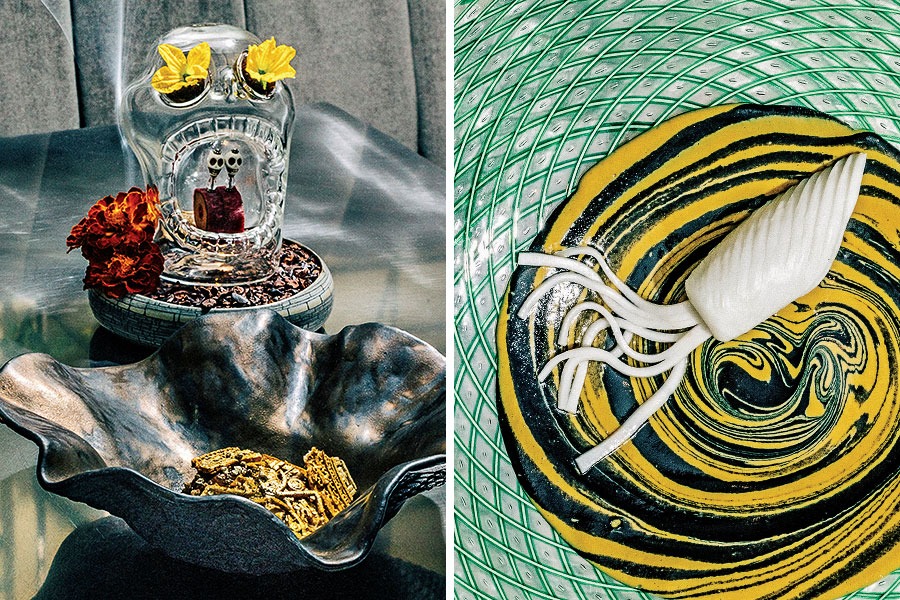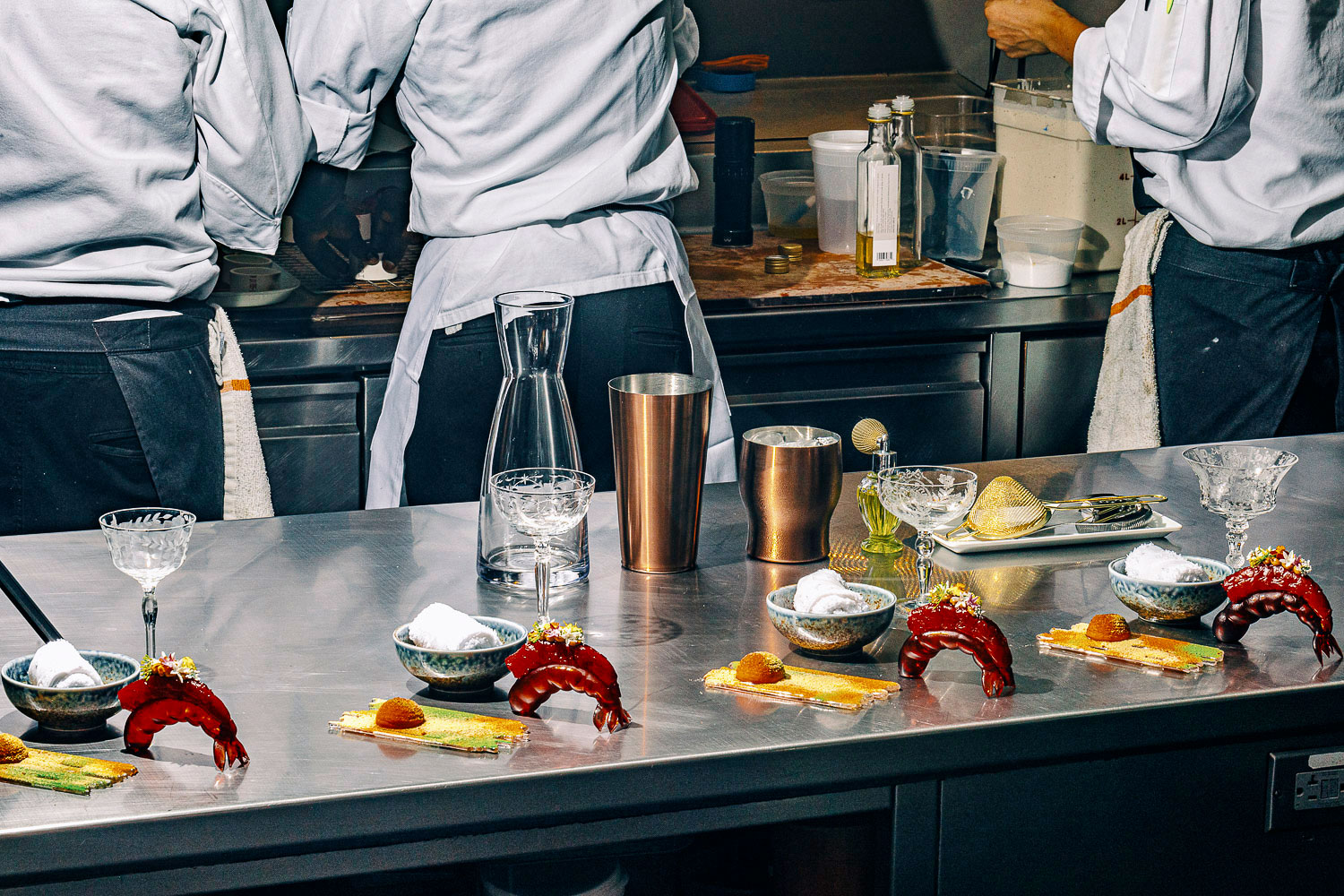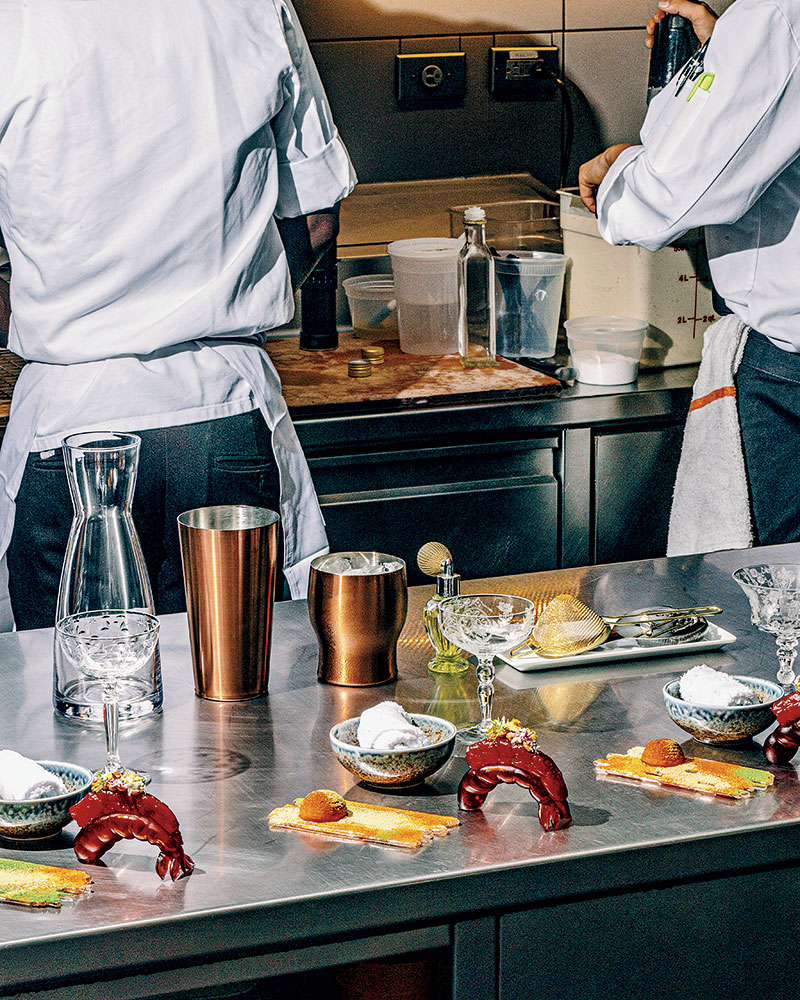Our meal’s third course, Trampoline Papillote, had the flavors of southern France literally all wrapped up. The papillote part of the dish looked familiar enough, a parchment bag I tore open to reveal a burst of steam and a tasty slice of scallop nestled on a tart sauce niçoise. The “trampoline” — a membrane cast from modified potato starch and stretched over a bowl of bouillabaisse — was new to me. The server hovered a spoon containing a yellow sphere of encapsulated aïoli above the bowl. It bounced twice on the surface, creating a fissure, then slipped inside. Hi, Alinea.
The combo is one of several edible tableaux that now define the dining experience at this once-groundbreaking Lincoln Park restaurant. Chef and co-owner Grant Achatz has rewritten the menu to unfold in thematic “blocks,” which can consist of a sole dish or more than half a dozen that fill the table with custom ceramics and centerpieces. They have cryptic names like Chipped, Japan Urchin, and Paint. Unlike before, when a meal could stretch into its fifth hour, this format offers just as many bites but finishes in a sprightly two or three hours. Smart move: It feels much more in tune with today’s dining mood. Alas, not much else about the experience did.
As the city’s only Michelin three-star restaurant, 17-year-old Alinea — now supervised by executive chef Douglas Alley — remains the pillar of the culinary community and a bucket list spot for diners. Astronomically expensive reservations vaporize in seconds, at least for the downstairs Gallery, billed as “a multi-sensory menu that combines fine dining with experimental moments.” After two months on the waiting list, I secured a spot in the Gallery at 9 p.m. on a Monday. I also dined in the upstairs Salon, which serves largely the same meal, albeit in eight blocks instead of 10, with a bit less razzle-dazzle and at three-quarters of the price.

In its early days, Alinea busted paradigms because it created indelible moments at the table: hot and cold in one slurp, truffle juice exploding, smell separated from taste, and ingredients seemingly switching bodies. Today, thanks largely to Alinea and its cohorts on the world stage, we have a much noisier and more exciting fine-dining world that has no truck with the stodgy, old-school past. Yet Alinea feels stuck in time, relying on its old bag of tricks. The sleights of hand have grown familiar, and the flavors don’t always add up. The food can be delightful, but it can also be too salty, too sweet, too off-key, and just too weird. Technical errors from the kitchen, like a cube of carrot in the bouillabaisse with an unpeeled corner, are picayune to be sure, but fissures in the sheen of perfection.
Sometimes the weirdness works. The rice bathed in a sauce of uni, coconut, and orange juice is such a dead ringer for Kraft mac and cheese that everyone stopped to marvel, if not question their brain synapses. Less fun is osetra caviar that has been pressed, dried, and grated into papery black shavings. The caviar’s three-dimensional flavor has been reduced to two: salty and fishy. It is accompanied by a chewy, hard-to-cut crêpe drenched in butter sauce that I gave up on during both visits.
Alinea feels stuck in time, relying on its old bag of tricks. The sleights of hand have grown familiar, and the flavors don’t always add up.
Alinea’s trademark legerdemain still creates real moments of joy and anticipation. If you dine in the five-table Gallery, the team serves plates in one grand gesture. Much like a carnival barker, the head captain stands in the center to announce each course. This works well in keeping the element of surprise: no peeping the neighboring table two courses ahead as you would in the Salon. When the assembled spectators receive the order to pick up a baton of Arctic char to eat with their fingers, you can feel the room reacting as one organism to the interplay of the fish’s lush texture and sweet cure with its brittle, bitter skin. Then you are instructed to find another element hiding in plain sight, a mousse studded with carrot pearls and smoked char roe. Too smoked — like a bottle of KC Masterpiece washed down with a shot of Laphroaig. If only I could eat with my eyes and not my tongue.
What else does the Gallery meal buy? A smoke machine that turns the room briefly into a Scottish moor and an intermission trip to the kitchen. There we drank a fine Corpse Reviver No. 2 and nibbled on a gorgeously pimped shrimp. We returned to find the dining room transformed by dim lighting and each table set with flaming centerpieces festooned with palm fronds and coconut shells. Thus began the most elaborate block of the evening, called Thailand.
This course, we were told, is all a riff on the flavor of coconut. Without spoiling the surprise, I’ll say that celery root makes such a grand entrance into this meal that I barely question its incongruity. The centerpiece dish of giant arrowhead squid in a two-tone coconut curry is tough and bouncy, but the bits of this and that have their charms, particularly a cube of coconut sponge cake that had been soaked in makrut lime oil and speared onto a frond.
The next block was Japan, and after that, as one server put it, we were “now going to Mexico.” This was where my reaction to the meal went from pleasurable befuddlement to full-on what-the-fuckery. The bowl of sweet mole held a shard of a broken Aztec sun stone (unlike the fully intact one in the National Museum of Anthropology in Mexico City). It is a masa cookie nestled among morel mushrooms, all as hard and stodgy as drywall and all painted bright gold. “Real 22-karat gold,” the head captain purred. “Because why not?” I mean, if you’re gonna join a room of rich people in eating the ruins of a vanquished native civilization, they might as well be gold, amirite?

Here, I think, is where Alinea falls completely out of step with the times. The best chefs today prioritize the cultural context of the food they make and use it to tell complex origin stories. Alinea globetrots for themes; its POV smacks of Orientalism. It’s hula night at the White Lotus. Sometimes it works. I loved a selection of tart and tangy pickles in the Japan course (available only in the Gallery), what Achatz called “our first foray into this type of fermentation.” More of this, please. It’s real. It resonates.
In his 2016 appearance on the Netflix docuseries Chef’s Table, Achatz describes a realization gleaned from his cancer ordeal in 2007. Radiation rendered him unable to taste for a period. But the sense did come back, first the primary tastes and then in its full glory. He saw how much of perception is a mental construct: “It’s up here,” he said, pointing to his head before dropping his hand to his mouth. “It’s not here.” He lards the menu with wordplay and flavor associations to challenge your neural pathways.
When you click with him, you feel it, particularly when he mines nostalgia. The Chipped block — with wagyu beef, air-dried bresaola, and white sauce — means to evoke the creamed chipped beef on toast once served at the Achatz family’s diner in Michigan. It dislodged a forgotten memory for me, but its sauce reeked of so much truffle oil as to destroy any balance. Not only that, but it comes with an overly sweet pistachio milkshake. Because we ordered the reserve pairings ($395 a pop), this was matched with a 1995 Château Haut-Brion, a first-growth Bordeaux that’s normally a treat for wine drinkers. But in this context, even Diet Coke would’ve been better.
On Chef’s Table, Achatz laid out the philosophy of the restaurant: “This is new. And then it’s new again.” Or is it? Every diner now expects the signature dessert, in place for well over a decade, of a tabletop painted with sauces, smashed freeze-dried ice cream, and glittery fairy dust. Staffers requested we move to one side of the table then asked for our cellphone to capture our photo with the dessert spread in front of us, a gastrotourist passport stamp. It’s an OK sundae, but more important, it seems, it’s an Instagram moment.
I watched a chatty, gorgeously dressed couple from the suburbs enthuse over their dessert and lean in for a picture. They had always wanted to come here and this was their first post-2020 splurge. I wish I could have experienced their joy.




